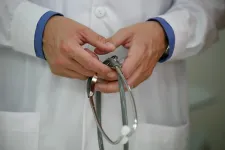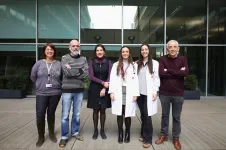(Press-News.org)
Researchers have discovered how a gene that increases the risk of developing genetic heart disease functions, paving the way for new treatments.
The study, led by Murdoch Children’s Research Institute and published in Nature Cardiovascular Research, has revealed a new pathway for how children and adults develop cardiomyopathy, a group of diseases that affect the heart’s ability to pump blood around the body.
Heart disease is the leading cause of death worldwide. Patients with cardiomyopathy, a form of heart disease affecting about 30 million people, are at greater risk of heart failure and death and treatment options are limited.
Dr James McNamara said the disease was often caused by genetic mutations that impacted heart muscle function. The gene, ALPK3 that controls the heart’s capacity to beat normally had been shown to increase cardiomyopathy risk when mutated, he said.
“Mutations in this gene can cause very severe and sometimes fatal cardiomyopathy in children,” he said. But it has been unknown what ALPK3 does in the heart and how its mutation causes disease.
“Our research is the first to show how ALPK3 directly controls the function of contractile proteins in the heart that drive normal pumping. We found that ALPK3 links these contractile proteins to quality control systems and that its mutation hinders this link, causing a build-up of damaged proteins. This impairs the heart’s ability to pump blood to the rest of the body, causing breathlessness, swollen legs and feet and extreme fatigue and if left untreated can lead to heart failure.”
The research used a combination of genetically engineered human stem cell models and mice to uncover the function of ALPK3 in the heart and to understand how it causes disease when mutated.
Murdoch Children’s Associate Professor David Elliott said the findings could lead to new drug discoveries to treat cardiomyopathy.
“With limited treatment options for patients, new targeted therapies are desperately needed,” he said. But armed with a greater understanding of how this gene works and by engineering stem cells in the lab to model genetic cardiomyopathy we can screen for new drugs and identify disease mechanisms. This could lead to new targeted treatments that restore heart function.”
Nicala Pearce’s son William, 16, was diagnosed as a newborn with hypertrophic cardiomyopathy, which caused him to frequently have cardiac arrests. Due to the condition, William was dependent on having those around him who knew CPR.
Nicala said with his cardiac episodes occurring every few months the family always had to brace themselves for the prospect he wouldn’t make it home one day. The constant dread began when William was just four and went into cardiac arrest at home.
“William was doing ok until he turned four and he had his first cardiac arrest,” Nicala said. I found him collapsed on the bedroom floor, unresponsive and I had to do CPR while my other son called for help. Once we arrived at the hospital he was put in a week long coma and after weeks of treatment he was able to come home.”
Following the attack William had to be implanted with a defibrillator to monitor and shock his heart if he went into cardiac arrest. A device he would have for the next eight years.
Nicala said due to his condition William couldn’t play sport or do any form of exercise.
“He wasn’t allowed to run or jump, couldn’t walk upstairs and lived a very sedentary life,” she said. It was like living with an invisible disability.”
But everything changed when William received a heart transplant four years ago.
“William is finally living and enjoying life,” Nicala said. He is playing footy, learning how to surf and going to the gym. He is embracing life to the full.”
Nicala said the new research by Murdoch Children’s would come as a huge relief to other families affected by the heart condition.
“With the condition there are limits to what doctors can do,” she said. As a mum you are always trying to find the answers to make things better but there was nothing we could do for William. This research will give so many families hope for the first time that new treatments could finally be discovered.”
Researchers from The Royal Children's Hospital, the University of Melbourne, The University of Sydney, Monash University, University College London, St. Bartholomew’s Hospital and QIMR Berghofer Medical Research Institute also contributed to the findings.
Publication: James W. McNamara, Benjamin L. Parker, Holly K. Voges, Neda R. Mehdiabadi, Francesca Bolk, Feroz Ahmad, Jin D. Chung, Natalie Charitakis, Jeffrey Molendijk, Antonia T.L. Zech, Sean Lal, Mirana Ramialison, Kathy Karavendzas, Hayley L. Pointer, Petros Syrris, Luis R. Lopes, Perry M. Elliott, Gordon S. Lynch, Richard J. Mills, James E. Hudson, Kevin I. Watt, Enzo R. Porrello and David A. Elliott. ‘Alpha kinase 3 signaling 1 at the M-band maintains sarcomere integrity and proteostasis in striated muscle. Nature Cardiovascular Research. DOI: 10.1038/s44161-023-00219-9
*The content of this communication is the sole responsibility of the Murdoch Children’s and does not reflect the views of the NHMRC.
Available for interview:
Dr James McNamara, Murdoch Children’s Research Officer, Heart Disease
Associate Professor David Elliott, Murdoch Children’s Group Leader, Heart Disease
Professor Enzo Porrello, Murdoch Children’s Theme Director, Stem Cell Biology
Nicala Pearce whose son William, 16, has hypertrophic cardiomyopathy
END
Researchers from Korea Advanced Institute of Science and Technology and University of Texas at Dallas published a new Journal of Marketing article that examines whether direct-to-consumer advertising for robotics surgery is effective at swaying patients to choose it over other types of procedures.
The study, forthcoming in the Journal of Marketing, is titled “The Role of Advertising in High-Tech Medical Procedures: Evidence from Robotic Surgeries” and is authored by Tae Jung Yoon and TI Tongil Kim.
Robotic surgery and the ethics ...
Taking vitamin D supplements may help ward off dementia, according to a new, large-scale study.
Researchers at the University of Calgary’s Hotchkiss Brain Institute in Canada and the University of Exeter in the UK explored the relationship between vitamin D supplementation and dementia in more than 12,388 participants of the US National Alzheimer's Coordinating Center, who had a mean age of 71 and were dementia-free when they signed up. Of the group, 37 per cent (4,637) took vitamin D supplements.
In the study, ...
Rounding checklists can help hospital care teams improve patient outcomes, and new research points to the potential for patient-specific checklists as a valid way to effectively translate the latest evidence into clinical practice.
These checklists can be helpful tools during daily rounds when multidisciplinary members of the patient care team convene to discuss each patient’s status and care plan. If too complex or generic, the checklists may instead become a burden, taking up valuable time with minimal impact.
One way to customize rounding checklists is to have an individual serve as a checklist prompter, listening to the conversation, eliminating ...
Research Highlights:
In a study of U.S. military veterans, researchers noted that participating in home-based cardiac rehabilitation was associated with a 36% lower risk of death compared to veterans who chose not to participate in cardiac rehabilitation.
Less than half of the study participants enrolled in rehabilitation, which focused on improving heart-healthy behaviors.
The research may be the first U.S. study to provide evidence of living longer with home-based cardiac rehabilitation in people with heart disease.
Embargoed until 4 a.m. CT/5 a.m. ET Wednesday, March 1, 2023
DALLAS, ...
Flamingos form cliques of like-minded individuals within their flocks, new research shows.
Scientists analysed the personalities and social behaviour of Caribbean and Chilean flamingos.
Birds of both species tended to spend time with others whose personality was similar to their own.
The study, by the University of Exeter and the Wildfowl & Wetlands Trust (WWT), reveals the complex nature of flamingo societies and could help in the management of captive flocks.
“Our previous research has shown that individual flamingos have particular ‘friends’ within the flock,” said Dr Paul Rose, from WWT and Exeter’s Centre for Research in Animal Behaviour.
“In ...
Toronto, ON — A new study published in the journal International Social Work has uncovered concerning rates of depression, post-traumatic stress disorder (PTSD) and anxiety among social workers.
Stressors related to COVID-19 were the strongest factors associated with the negative mental health outcomes. Those who experienced a higher number of pandemic-related stressors — such as health concerns, increased caregiving responsibilities, violence in the home, family stress due to confinement, and stress associated with work-life balance — experienced mental health problems ...
The mainly brown woodcock uses its bright white tail feathers to communicate in semi-darkness, reflecting 30% more light than any other known bird.
These surprise findings, by a team led by an Imperial College London scientist, suggest there is much to learn about how birds that are most active at night or at dawn and dusk communicate.
Birds that are most active during the day often have colourful plumages, which they use to communicate information with each other. Birds that are most active at dawn and dusk or at night (‘crepuscular’), such as nightjars and woodcocks, tend to have less showy plumage, as while sleeping during ...
Cells that form cutaneous squamous cell carcinoma tumours prepare themselves to migrate to the lymph nodes to metastasise other organs, and they make changes so that they can survive this process. According to a study led by researchers from the Inflammatory and Neoplastic Dermatological Diseases Research Group at the Hospital del Mar Medical Research Institute, published in the journal Life Science Alliance, these cells stop consuming glucose so that they can survive by using LDL cholesterol molecules, the ...
Although cable locks – commonly distributed to prevent firearm injury and death – are included in many legal firearm purchases, research shows firearm owners rarely prefer or use these devices.
But a Rutgers study published in Injury Epidemiology found that gun owners who were told about cable locks at the time they purchased the firearm were more than twice as likely to use locking devices than those who weren’t told about cable locks when they made these purchases.
“Simply placing a cable lock in a bag when somebody purchases a firearm likely has minimal impact, but a simple discussion mentioning that a lock was included may make enough of an ...
One in ten early deaths could be prevented if everyone managed at least half the recommended level of physical activity, say a team led by researchers at the University of Cambridge.
In a study published today in the British Journal of Sports Medicine, the researchers say that 11 minutes a day (75 minutes a week) of moderate-intensity physical activity – such as a brisk walk – would be sufficient to lower the risk of diseases such as heart disease, stroke and a number of cancers.
Cardiovascular diseases – such as heart disease and stroke – are the leading cause of death globally, ...





